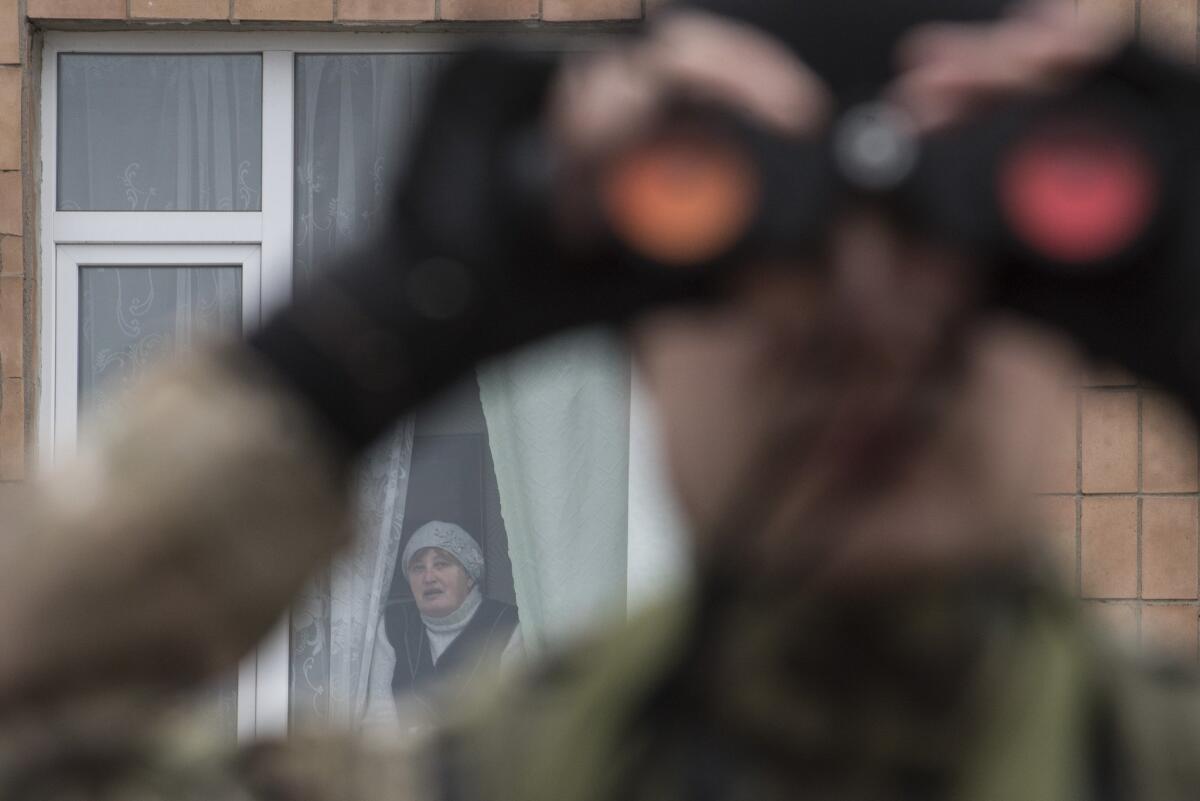Ukraine, separatists say they are pulling back heavy weapons

- Share via
Ukrainian defense officials and leaders of the separatist rebellion in eastern Ukraine announced Thursday that they were moving tanks and other heavy weaponry away from the front lines in a belated effort to abide by the conditions of a European-brokered peace agreement.
But both sides warned that the movement would be reversed if their opponents sought to take advantage of the lull in shooting that has finally occurred more than a week after the cease-fire was to have taken effect.
Under the peace plan hammered out Feb. 12 during marathon negotiations in Minsk, the capital of Belarus, the combatants were supposed to have begun the weapons pullback on Feb. 16, the day after the cease-fire went into force, and to have completed the moves within two weeks.
The Russian-backed separatists unleashed fierce artillery barrages for days after the purported cease-fire start and succeeded in taking the strategic railway junction town of Debaltseve before halting offensives.
Ukrainian defense officials and political leaders had said they could not meet the Minsk schedule for weapons withdrawal because of the continued attacks on government positions.
Col. Andriy Lysenko, spokesman for Ukraine’s National Security and Defense Council, told reporters in Kiev on Thursday that fighting had finally died down enough to begin complying with the weapons pullback, which by the peace plan’s timetable should be completed by Sunday.
The Interfax-Ukraine news agency quoted Ukrainian military spokesman Anatoly Stelmakh as saying the government forces were moving their 100-millimeter anti-tank guns 16 miles back from the front line, as stipulated by the deal brokered in Minsk by German Chancellor Angela Merkel and French President Francois Hollande.
“Pursuant to the Minsk agreements, the ATO [anti-terrorist operation] forces have begun to withdraw the artillery systems from the entire line of contact,” Defense Ministry spokesman Oleksandr Motuzianyk told the Ukrinform news agency in Kiev, adding that the weapons would be concentrated in areas monitored by the Organization for Security and Cooperation in Europe.
A Defense Ministry statement, however, warned that the government reserved the right to scrap the pullback if rebel attacks on their positions resume.
Alexander Zakharchenko, leader of the separatists’ self-proclaimed Donetsk People’s Republic, also announced that a weapons withdrawal was underway.
“Donetsk has withdrawn 90% of heavy weaponry from the line of contact,” Zakharchenko was quoted as saying by Russia’s Sputnik news agency.
But he added that unless the Ukrainian government complied with the pullback condition of the peace plan by 7 p.m. Friday Moscow time his forces would “return heavy weapons to where they were on February 12.”
The first significant signs that the Minsk accord is tamping down the violence in eastern Ukraine coincided with announcements from Ukrainian allies in Western Europe and the United States that training and equipment were on the way to better prepare the outgunned government forces to defend against future onslaughts.
Polish Defense Minister Tomasz Siemoniak said in a televised announcement late Wednesday that Polish military instructors would be deployed to bases near Kiev and outside Lviv, a city on Ukraine’s western border with NATO members Poland, Slovakia and Hungary.
British Defense Secretary Michael Fallon had announced two days earlier that 75 British military trainers would be in Ukraine from mid-March to help government forces improve their capabilities in intelligence, communications, logistics and first aid.
The Pentagon also said Tuesday that it was sending a second medical training team to Ukraine next week to build on the skills imparted to 300 Ukrainian battlefield medics during the first phase last year.
Meanwhile, support in Congress and among U.S. foreign policy advisors continued to grow for providing Ukraine with better weapons and equipment if the latest cease-fire fails.
Merkel and most U.S.-allied leaders in Western Europe oppose lethal aid to the embattled Kiev government, arguing that more weapons will mean more fighting and death.
More than 5,800 people have been killed in eastern Ukraine since pro-Russia separatists seized government buildings and security installations in the Donetsk and Luhansk regions in April. Their actions were widely viewed as inspired by Russia’s invasion a year ago of Ukraine’s Crimea region and annexation of the strategic Black Sea peninsula on March 18.
Follow @cjwilliamslat for the latest international news 24/7
More to Read
Sign up for Essential California
The most important California stories and recommendations in your inbox every morning.
You may occasionally receive promotional content from the Los Angeles Times.











